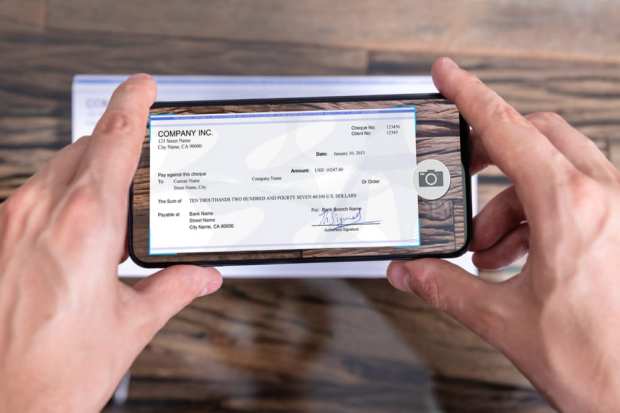How ‘Pandenomics’ Will Drive Mobile Check Deposits

“Pandenomics” may usher in a new age for mobile check capture and deposits.
In an interview with Karen Webster, Mike Diamond, general manager of digital banking at Mitek, said it’s unlikely that customers will revert back to their branch-intensive, pre-pandemic banking behaviors. In fact, we might not go back to the bank in person at all unless we have to, say, sign and notarize a mortgage document or cash a (paper) cashier’s check.
“Some consumers will go back to banks, but we are not going to snap back to pre-COVID days,” Diamond said. “We never will. It’s impossible to be unchanged by the pandemic. The future has been forced on the financial industry.”
One might call the changes wrought by the coronavirus a case of “pandenomics” — a phrase first coined and minted by PYMNTS’ Webster, and recently part of a discussion about the “new normal” between Webster and Patrick Gauthier, vice president at Amazon Pay.
Pandenomics dictates that consumers make daily choices through the prism of how those choices might impact their health. In other words, safety reigns supreme.
Diamond said that in a world where some businesses are reopening even though there’s no COVID-19 vaccine yet, “going into a bank branch to do workaday banking transactions may not be a smart move for a lot of people. And using what might be perceived as a ‘germ-laden’ ATM is not exciting to a lot of people.”
Does Growth In Mobile Texts Portend Growth In Mobile Checks?
Against that backdrop, there’s room for mobile check deposit to enter its next leg of growth.
To get a sense of how mobile checking activity might get a tailwind from the pandemic, Diamond pointed to the mushrooming of text messaging over the past decade or so.
Nowadays, we all text — some of us incessantly. But not that long ago, SMS was a little-used means of communication. Then came “American Idol,” and voting for contestants by text. In the wake of Hurricane Katrina, donating by text to charities also caught on.
In other words, there’s a zigzag pattern toward mass adoption of new technologies, but the trend is an inexorable one — and digital banking seems primed for that.
But Diamond said financial institutions (FIs) can’t simply layer a digital veneer on top of legacy infrastructure, or in some cases simply mandate that some services and products remain strictly brick-and-mortar.
At a high level, “digital is not simply a technology, it’s a habit of mind,” he said.
Diamond said he believes mobile deposit capture is ready to move into that new age. He said the first era of mobile check deposit years ago might be likened to “happy days are here again,” where growth was “up and to the right,” fueled by banks’ advertising campaigns. Off of a low base, growth doubled or tripled without much strain on banks’ part.
But then came the hard part. Diamond said some 15 percent to 20 percent of checks on the retail-banking side were coming in through mobile pre-pandemic — a good start, but not enough.
He said part of the friction impeding mass adoption is the fact that consumers are “nervous” about using a new, tech-enabled method to get deposits into their accounts.
“But when those same people are shown how to use mobile check deposit, they say: ‘Wow, this is great,’” Diamond said.
He said banks need to be proactive in calling attention to (and guiding consumers toward) this digital option by boosting visibility of demos or even redefining new account openings. For example, Diamond said banks can require taking customers through mobile deposits as a pre-condition to onboarding new accounts.
After all, there’s at least some duplication of process when checks are handed to tellers. As Diamond told Webster, when consumers bring checks into a branch, they’re effectively “walking out of [a] house, getting into a car, driving across town, arriving at the branch, standing in line, handing a check to them — and basically saying, ‘Will you take a picture of this for me?’”
If banks simply explain that consumers can take the same picture from the comfort of their kitchens, the behavioral change will be all that much easier to influence, he said.
Additional notifications from the bank — perhaps a graphic “thumbs up” confirming that a check has been received and cleared — can soothe consumer nervousness over the process. He said it’s up to banks to deliver a great user interface that also stays true to regulatory obligations.
Diamond said the “inherent power of mobile check deposit is that it meets people where they live today” — namely, pretty much everyone has a cellphone equipped with a camera. Having tech at the ready might go a long way toward dislodging the paper check — which has been sticky indeed, with billions of them sent through the mail each day despite repeated predictions of their demise.
However, checks are on a slow, gentle, long-term decline as digital channels gain traction and the means of building, assessing and ensuring trust through robust digital ID verification improve.
But as for branch visits related the checking and other everyday banking needs, Diamond told Webster, “I don’t think we’re ever going to go back. This is absolutely a watershed moment in the financial services industry.”
